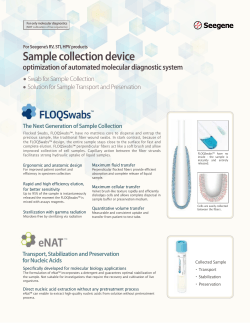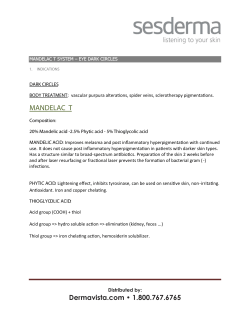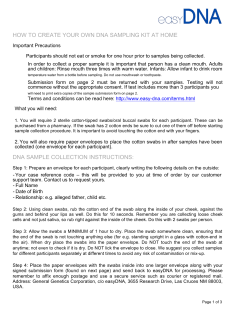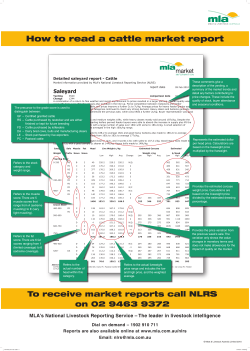
Availability of oral swab sample for the detection of bovine Title
Title Author(s) Citation Issue Date Availability of oral swab sample for the detection of bovine viral diarrhea virus (BVDV) gene from the cattle persistently infected with BVDV Tajima, Motoshi; Ohsaki, Tomohiro; Okazawa, Manabu; Yasutomi, Ichiro Japanese Journal of Veterinary Research, 56(1): 3-8 2008-05 DOI Doc URL http://hdl.handle.net/2115/33848 Right Type bulletin Additional Information File Information 56-1_p3-8.pdf Instructions for use Hokkaido University Collection of Scholarly and Academic Papers : HUSCAP Japanese Journal of Veterinary Research 56(1): 3-8, 2008 FULL PAPER Availability of oral swab sample for the detection of bovine viral diarrhea virus (BVDV) gene from the cattle persistently infected with BVDV Motoshi Tajima1), Tomohiro Ohsaki1), Manabu Okazawa2) and Ichiro Yasutomi3) 1) Veterinary Teaching Hospital, Graduate School of Veterinary Medicine, Hokkaido University, Sapporo 060-0818, Japan 2) NOSAI Okhotsk, Yubetsu 093-0731, Japan 3) Yubetsu Herd Management Service, Yubetsu 093-0731, Japan Received for publication, April 8, 2008; accepted, May 8, 2008 Abstract Bovine nasal and oral discharges were used as samples for bovine viral diarrhea virus (BVDV) gene detection. Viral genes in serum (S), nasal discharge (N) and oral discharge (O) were quantified with real-time polymerase chain reaction using SYBR Green by the relative quantification method, and findings were compared among samples. Although the quantity of the BVDV gene in S was greater than those in N and O, all samples were available to identify persistently infected (PI) cattle with BVDV by reverse transcription polymerase chain reaction (RT-PCR). The swab samples were able to be stored for a few days at 4℃with a little decrease of amplification signal in RT-PCR. Oral swab sampling was easier than nasal swab sampling, and was also less uncomfortable for the cattle than other sampling methods without pain or unnecessary retention. This sampling method can be performed without any special technique and equipment. Therefore, the oral swab sampling method is useful for screening to detect BVDV PI cattle by RT-PCR. Key Words: bovine viral diarrhea virus, BVDV, gene detection, swab sampling Bovine viral diarrhea virus (BVDV) is distributed all over the world15). There are many BVDVinfected cattle that do not show the typical clinical manifestations of diarrhea and mucosal diseases. These cattle including those persistently infected (PI) with BVDV are a latent source of infection of BVDV in the herd, which could cause serious eco- nomic damage to the farmer4,9). Detection and elimination of BVDV from the herd are important to prevent its spread11, 12). In the dairy herd, bulk tank milk (BTM) is an available sample for the detection of BVDV. To identify PI cattle in BTM testpositive herd, serum or leukocytes are usually collected from individual cattle on the farm. In the *M. Tajima, Veterinary Teaching Hospital, Graduate School of Veterinary Medicine, Hokkaido University, Sapporo 060-0818, Japan Phone: +81-11-706-5100. Fax: +81-11-706-5100. E-mail: motoshi@vetmed.hokudai.ac.jp 4 Oral swab for the detection of BVDV gene present study, more convenient and easier methods of collecting samples to detect BVDV by reverse transcription polymerase chain reaction (RTPCR) from individual cattle were evaluated. Nasal and oral discharges were used as samples for BVDV detection. They were collected by swab and the swabs were stored in 2 ml of saline. Then 140 µl of these samples were used for the extraction of RNA. RNA was extracted using QIAamp Viral RNA Mini Kit (Qiagen Inc., Tokyo, Japan) according to the manufacturer’s instructions. Synthesis of cDNA was carried out using Moloney murine leukemia virus reverse transcriptase (MMLV-RT, Invitrogen Inc., Tokyo, Japan) and a random hexamer (Promega Inc., Tokyo, Japan) 14). Specific primers13) for 5’ UTR of BVDV1and BVDV 2 were used for the detection by RT-PCR. The cycling conditions were 94° C for 1min, 35 cycles (denaturation at 94° C for 30 sec, annealing at 55° C for 30 sec and extension at 72° C for 30 sec) and a final extension step (72° C for 2.5 min). The amplification was confirmed by 2% agarose gel electrophoresis after RT-PCR. The viral genes in serum (S), nasal discharge (N) and oral discharge (O) were quantified with the real-time PCR method using SYBR Green (Applied Biosystems Japan Inc., Tokyo, Japan) by the relative quantification method (qPCR), and findings were compared among samples. The conditions for real-time PCR were 50° C for 2 min, 50 cycles (denaturation at 94° C for 30 sec, annealing at 55° C for 30 sec and extension at 72° C for 60 sec) and a dissociation step for the confirmation of specific amplification. The primers were the same as those for RT-PCR and the reaction mixture was prepared according to the manufacturer’s instructions for SYBR Green. The number of copies of BVDV gene per µl of sample was estimated from the 10 times serial dilutions of 10 ng of amplified products corresponded to 3.67×1010 copies. The standard curve showed a highly significant (R2= 0.999) negative correlation between the threshold cycle (Ct) value and gene copies/µl (Fig. 1). The number of gene copies was calculated using the molecular weight of the amplified product (242 bp) and Avogadro’s number. By RT-PCR, specific amplification bands of BVDV gene were recognized using S, N and O as examination samples. It has been reported that the sensitivities of virus isolation (VI) and RT-PCR for detecting BVDV were almost the same or RTPCR was high sensitivity5,6,8). Moreover, nasal, ocular and tracheal swabs and sera showed the same results for the detection of BVDV by VI and RTPCR5). In the present study, although the quantity of the BVDV gene in S was greater than those in N and O by real-time PCR, the appearances of the bands on agarose gel electrophoresis were almost the same among the three samples (Fig. 2). By qPCR, the quantities of viral gene from 13 PI cattle were estimated. The relative quantities of viral gene calculated by Ct differed individual PI cattle between 105 to 107 copies/µl of serum. Thus the results of qPCR of swabs were evaluated as relative value against that of serum sample. As shown in Table 1, in 6 of 13 PI cattle, oral swabs included more virus gene than serum. This was thought depend on the sampling manner in the field such as manipulation of the cotton stick (vigorously or mild in oral or nasal cavity), volume of saline, and so on, because the samples were collected from individual BVDV-PI cattle by different operators (veterinarian or farmer). In general, serum did not include the cells, however, swab samples sometimes included some cells by vigorous manipulation of the cotton stick. In all cases, the amplification bands of RT-PCR appeared almost the same on gel electrophoresis, therefore, swab samples could be used for the detection of PI-cattle by RT-PCR. This indicated that RT-PCR was satisfiable method and swab was enough as the examination sample. All samples could be stored for a few days at 4° C with a little decrease of amplification signal on RT-PCR. However, freezing and thawing of the swab sample markedly decreased amplification signal. These could be easily recognized on RT-PCR as shown in Fig. 3. The decreasing of signal by freezing might resulted from the freezing damage by saline as stock solution of cotton stick. The causes could not identify in the present study. Motoshi Tajima et al. 5 Fig. 1. Correlation between the BVDV gene copies and the threshold cycle (Ct). (a) The number of copies of the BVDV gene per µl of sample was estimated from the 10 times serial dilutions (1 to 10-6) of 10 ng of amplified products. The curves of each dilution were indicated from the results of triplicate reactions. (b) The standard curve showed a highly significant (R2=0.999) negative correlation between the Ct value and the number of gene copies. By the use of oral swab sampling, 1,488 newborn beef calves were examined by RT-PCR in 2 farms for a year. 2 PI calves were detected. Acute infection could not be identified from swab sam- Oral swab for the detection of BVDV gene 6 Fig. 2. Amplification signal of real-time PCR of viral gene in each sample S, serum; O, oral swab sample; N, nasal swab sample. Appearance of 2% agarose gel electrophoresis is almost same each other. Table 1. Relative quantities of gene copies in the each sample from BVDV-PI cattle Cattle No. Breed1) Age (Months) Genotype Serum2) Oral2) Nasal2) K492 F1 1 1b 1 0. 03 0.65 K512 Hol 37 1b 1 0. 34 0.42 76 Hol 1 1b 1 17. 15 4.66 2 Hol 1 1a 1 17. 68 NT 408 JB 1 1c 1 0. 04 1.84 409 JB 1 1c 1 0. 57 1.09 AK2025 JB 6 1b 1 0. 05 NT 602 F1 1 1b 1 10. 63 NT 631 Hol 1 1b 1 1. 26 NT IZ JB 6 2 1 0. 16 1.57 45 Hol 45 1a 1 0. 11 0.11 52 JB 1 1b 1 6. 95 6.37 600 Hol 40 1a 1 1. 08 5.38 1) Hol, Holstein; JB, Japanese Black; F1, Mix Relative quantity is indicated as relative value (Rv) calculated by following equation. Rv=the number of copies of BVDV gene in the sample/the number of copies of BVDV in serum The number of copies computed by Fig. 1-b). NT: not tested 2) ples in the present study. Also Antonis et al.1) reported that acute infection of BVDV could not isolated from swab sample but peripheral leukocyte in experimentally infected calf with BVDV. BVDV distributes throughout the body of PI cattle2,10). PI cattle spread the virus in the herd through nasal discharge, saliva, urine, feces, blood, milk, and so on. Serum or leukocytes are usually used as a sample for BVDV detection. In North America, an ear notch skin sample is widely utilized for the detection of BVDV by immunohistpathological examination or enzyme linked immunosorbent assay3,7). A scrap of ear lobe obtained during the attachment of ear tag is usually used as Motoshi Tajima et al. 7 Fig. 3. Appearances of RT-PCR amplified products of serum and oral swab samples from a PI cattle in different store conditions. S, serum sample; O, oral swab sample. (a) Different storage period between 0 to 8 days at 4° C. Immediate, manipulation of RNA extraction started within few minutes after swab sampling. 0 day, stored 4 hrs. (b) Each sample stored at 4° C or -30° C for a day. a sample. In Japan, ear tags are attached by the pierce method, without a skin piece being extruded during attachment. Therefore, the ear-notch method is not widely used for surveillance of PI cattle in Japan. Oral swab sampling was easier than nasal swab sampling, and was also less uncomfortable for the cattle than the other sampling methods such as blood collection and ear notching, without pain causing or unnecessary retention. This sampling method can be performed without any special technique and equipment. Therefore, the oral swab sampling method is useful for the screening to detect BVDV. We are grateful to the veterinary practitioners of Hokkaido Agricultural Mutual Aid Associations for their cooperation. This work was supported by a grant-in-aid from the Ministry of Education, Science, Sports and Culture, Japan, and the Ministry of Agriculture, Forestry and Fisheries of Japan. 2) 3) 4) 5) References 1) Antonis, A. F. G., Bouma, A., Bree, J. and Jong M. C. M. 2004. Comparison of the sensitivity of 6) in vitro and in vivo tests for detection of the presence of a bovine viral diarrhoea virus type 1strain. Vet. Microbiol., 102: 131-140. Bielefeldt-Ohmann, H., Tolnay, A. -E., Reisenhauer, C. E., Hansen, T. R., Smirnova, N. and Van Campen, H. 2008. Transplacental infection with non-cytopathic bovine viral diarrhoea virus types1b and 2: viral sprea and molecular neuropathology. J. Comp. Pathol., 138: 72-85. Brodersen, B. W. 2004. Immunohistochemistry used as a screening method for persistent bovine viral diarrhea virus infection. Vet. Clin. North Am. Food Anim. Pract., 20: 85-93 Gunn, G. J., Saatkamp, H. W., Humphry, R. W. and Stott, Q. W. 2005. Assessing economic and social pressure for the control of bovine viral diarrhoea virus. Prev. Vet. Med., 72: 149-162. Hamel, A. L., Wasylyshen, M. D. and Nayar, G. P. S. 1995. Rapid detection of bovine viral diarrhea virus by using RNA extracted directly from assorted specimens and a one-tube reverse transcription PCR assay. J. Clin. Microbiol., 33: 287-291. Kennedy, J. A. 2006. Diagnostic efficacy of a reverse transcriptase-polymerase chain reaction 8 Oral swab for the detection of BVDV gene assay to screen cattle for persistent bovine viral diarrhea virus infection. J. Am. Vet. Med. Assoc., 229: 1472-1474. 7) Kennedy, J. A., Mortimer, R. G. and Powers, B. 2006. Reverse transcription-polymerase chain reaction on pooled samples to detect bovine viral diarrhea virus by using fresh ear-notchsample supernatants. J. Vet. Diag. Invest., 18: 89-93. 8) Kim, S. G. and Dubovie, E. J. 2003. A nobel simple one-step single-tube RT-duplex PCR method with an internal control for detection of bovine viral diarrhoea virus in bulk milk, blood, and follicular fluid samples. Biologicals, 31: 103-106. 9) Kozasa, T., Tajima, M., Yasutomi, I., Sano, K., Ohashi, K. and Onuma, M. 2005. Relationship of bovine viral diarrhea virus persistent infection to incidence of disease on dairy farms based on bulk tank milk test by RT-PCR. Vet. Microbiol., 106: 41-47. 10) Liebler-Tenorio, E. M., Ridpath, J. F. and Neill, J. D. 2004. Distribution of viral antigen and tissue lesions in persistent and acute infection with the homologous strain of noncytopathic 11) 12) 13) 14) 15) bovine viral diarrhea virus. J. Vet. Diag. Invest., 16: 388-396. Lindberg, A. L. E. 2003. Bovine viral diarrhoea virus infections and its control. A review. Vet. Q., 25: 1-16. Moennig, V., Houe, H. and Lindberg, A. 2005. BVD control in Europe: current status and perspectives. Anim. Health Res. Rev., 6: 63-74. Radwan, G. S., Brock, K. V., Hogan, J. S. and Smith, K. L. 1995. Development of a PCR amplification assay as a screening test using bulk milk samples for identifying dairy herds infected with bovine viral diarrhea virus. Vet. Microbiol., 44: 77-92. Tajima, M., Kirisawa, R., Taguchi, M., Iwai, H., Kawakami, Y., Hagiwara, K., Ohtsuka, H., Sentsui, H. and Takahashi, K. 1995. Attempt to discriminate between bovine viraldiarrhoea virus strains using polymerase chain reaction. J. Vet. Med., B42: 257-265. Tajima, M. 2006. The prevalent genotypes of bovine viral diarrhea virus in Japan, Germany and the United States of America. Jpn. J. Vet. Res., 54: 129-134.
© Copyright 2025









